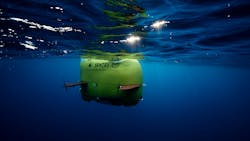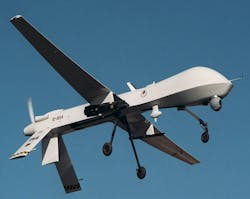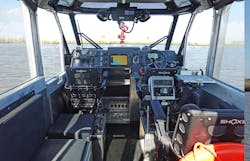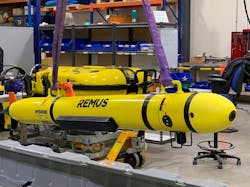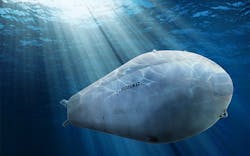Unmanned vehicle systems: ready for takeoff
By Jim Romeo
NASHUA, N.H. - Unmanned vehicle systems incorporate many different modes and variants being developed within the U.S. Navy, Army, Air Force, Marine Corps, and Coast Guard. Such a description is fitting, given the many different variants of remotely operated, unmanned assets for air, sea, underwater, and land operations.
Technology is advancing, and as it advances, programs are jockeying for funding and political support to build a strategic array of assets that can bring a new and improved dimension to the overall missions of the service branches for national defense and maritime support.
Program support across service branches
In 2022, the Congressional Research Service emphasized the prominence and emergence of unmanned vehicles, namely unmanned underwater vehicles (UUVs) and unmanned surface vessels (USVs).
A recent report by the Congressional Research Service, "Navy Large Unmanned Surface and Undersea," updated in September, outlined the budgetary considerations for three categories of unmanned vehicles: large unmanned surface vehicles (LUSVs); medium unmanned surface vehicles (MUSVs); and extra-large unmanned undersea vehicles (XLUUVs).
According to the report: “The Navy’s proposed fiscal 2024 budget requests $117.4 million for LUSV research, $85.8 million for the MUSV program, $176.3 million for LUSV/MUSV enabling capabilities, $104.3 million for the XLUUV program, and $71.2 million for core technologies for UUVs including but not limited to XLUUV.”
The continues "the issue for Congress is whether to approve, reject, or modify the Navy’s acquisition strategies and funding requests for these large UVs [unmanned vessels]. The Navy’s proposals for developing and procuring them pose several oversight issues for Congress. Congress’s decisions on these issues could substantially affect Navy capabilities and funding requirements and the shipbuilding and UV industrial bases ... the Navy also wants to develop and procure smaller USVs and UUVs, as well as unmanned aerial vehicles (UAVs) of various sizes. Other U.S. military services are developing, procuring, and operating their own types of UVs."
Regarding unmanned aircraft systems (UAS) the Congressional research service reported in July 2022 in a report "Unmanned Aircraft Systems: Roles, Missions, and Future Concepts," that UAS assets are specifically part of a modernization strategy.
The report stated that "Unmanned aircraft systems (UAS) have gained increased prominence in U.S. military operations. The Department of Defense (DOD) is currently developing advanced UAS, along with optionally crewed aircraft, as part of its modernization strategy. The roles and missions of UAS are relevant to Congress in authorizing, appropriating, and providing oversight to DOD and the military services for these systems."
Replacing crewed aircraft?
The report proposed that unmanned could replace crewed aircraft for missions such as aerial refueling; air-to-air combat; strategic bombing; battle managementIn addition, the report stated that DOD is "developing several experimental concepts—such as aircraft system-of-systems, swarming, and lethal autonomous weapons—that explore new ways of employing future generations of UAS. In evaluating appropriations and authorizations for potentially new and future UAS programs, missions, and concepts."
More specifically, the Congressional research service reported in July 18 2022 in a report "Unmanned Aircraft Systems: Roles, Missions, and Future Concepts," stated that UAS assets specifically are part of a modernization strategy.
The report stated that "Unmanned aircraft systems (UAS) have gained increased prominence in U.S. military operations. The Department of Defense (DOD) is currently developing advanced UAS, along with optionally crewed aircraft, as part of its modernization strategy. The roles and missions of UAS are relevant to Congress in authorizing, appropriating, and providing oversight to DOD and the military services for these systems."
Proposing that they could replace crewed aircraft for several missions, including aerial refueling; air-to-air combat; strategic bombing; battle management and command and control (BMC2); suppression and destruction of enemy air defenses; and electronic warfare (EW).
In addition, the report stated that DOD is "developing several experimental concepts—such as aircraft system-of-systems, swarming, and lethal autonomous weapons—that explore new ways of employing future generations of UAS.
In the same report to Congress, the research service reported that the Air Force has begun to use the term “un-crewed” to describe remotely piloted or unmanned aircraft systems. They explain that The Air Force made this distinction "defining all aircraft flying without an aircrew onboard after it started developing optionally crewed aircraft, like the B-21 Raider.5 An emerging class of UAS is loitering munitions—also called “Kamikaze drones”—which serve as a single use aircraft flying for extended periods of time (from dozens of minutes to potentially hours) that can observe and engage targets. This report uses the terms crewed and un-crewed to distinguish between different types of aircraft, and the term UAS for the broader system."
Coast guard involvement
The U.S. Coast Guard explained in the March 2023 report "Deputy Commandant for Operation, Unmanned Systems Strategic Plan, a plan to incorporate unmanned systems to assist in a broad range of Coast Guard missions.
The Deputy Commandant's opening statement explained that: "In order to meet the challenges of an increasingly dynamic operational environment, we mustIn evaluating appropriations and authorizations for potentially new and future UAS programs, missions, and concepts. "The Congressional Research Service also focused on The Army’s Robotic Combat Vehicle (RCV) Program, " describing it as "a vehicle being developed as part of the Army’s Next Generation Combat Vehicle (NGCV) family of vehicles."
They stated that the Army plans to develop three RCV variants: light, medium, and heavy. "The Army reportedly envisions employing RCVs as scouts and escorts for manned fighting vehicles to deter ambushes and to guard the flanks of mechanized formations. As originally planned, RCVs are to be controlled by operators riding in NGCVs, but Army leaders say they hope that improved ground navigation technology and artificial intelligence (AI) might eventually permit a single operator to control multiple RCVs or for RCVs to operate in a more autonomous mode."
Boosting the utility of unmanned vehicles
There are many key initiatives in technology that help build the utility of unmanned air, underwater, and unmanned surface vessels. Such initiatives evolve over time and are improving as things like navigation systems, tracking technology, and positioning all improve with more drive to make unmanned vehicles useful to defense strategies and plans.
Scott Savitz is a senior engineer at the RAND Corporation, a technology think tank in Santa Monica, Calif. Savits says that in a nutshell, so much comes down to autonomy of the vehicle and controlling the same.
"The biggest drivers are improvements in autonomy and remote control," says Savitz. " Undersea vessels must operate almost wholly autonomously, and surfaceBrandon Tseng is the president and co-founder at Shield AI in San Diego. From his perspective, there are many different facets of technology that must be considered when discussing how and what success with unmanned vehicles are influenced by.
One such development is the development of intelligent mass (teams of drones) and AI pilots (similar to self-driving technology): Enabling operations even when GPS and communications are jammed, these technologies are vital for tracking, targeting, and striking.
"Their development represents a paradigm shift in autonomous warfare, reducing costs and increasing efficacy and Shield AI is one of very few companies developing these capabilities today," says Tseng. "AI and autonomy software on un-crewed aircraft allows for quicker, more precise decision-making, independent of human reaction time and judgment.
Tseng points out some areas that should be focal points of effort and investment in future technology initiatives to implement unmanned vehicles.
"Increased Funding for AI pilots and AI/autonomy on the edge are key. "Recognizing the strategic importance of AI pilots, on par with stealth, nuclear, and hypersonic technology, there must be a significant increase in funding," says Tseng. "The disparity in current resourcing could lead to astronomical costs in conflict, as the situation with China and Taiwan may illustrate."
Tseng also highlights the importance of adaptation to a future that will be dominated by electronic warfare, as he says, "like we are seeing in Ukraine. With operations in contested areas like the South China Sea and Black Sea, new technologies and approaches must adapt to the challenges of GPS/comms jamming and integrated air defenses," explains Tseng. "Low-cost drones and AI pilots – that can operate even when GPS and communications are jammed, and can track, target, and strike – are critical to winning any resultant conflict."
Tseng says that advancements in low-cost drones, AI pilots, and various unmanned systems are setting new benchmarks in defense technology. "The sector's future focus should include a strong emphasis on increased funding, edge autonomy, adaptation to diverse operational environments, and reevaluation of traditional defense configurations," he says. "The urgency of these developments is underscored by the geopolitical tensions and the emerging needs of modern warfare."
Meeting technological challenge
With the development of new and better technology to promote unmanned vessels, comes continuous challenges that stand in the way of development, testing, and implementation of effective unmanned vehicles. Identifying and working around such challenges means finding and developing better critical paths to new success in the use of unmanned craft and vehicles.
"Textron Systems is currently focusing on autonomous navigation in USVs," says Schaffernocker. "There is ongoing research and development in industry for hardware and computing resources needed to implement these new technologies. Implementing autonomy allows for the sailor to be less in harm's way while still working with the system. A notable trend is that smaller platforms are becoming more affordable due to the advancements in phone technology like GPS, mems-based INS and camera technologies. Algorithms continue to advance, and hardware systems are increasingly moving from analog to digital across all vessel platforms. Sensors are used to identify what the environment looks like; what objects are in that environment and what they’re predictably doing."
Emil Kheyfets is the director for military and aerospace business development at Aitech in Chatsworth, Calif. Kheyfets, like others, emphasizes the importance of AI.
"The biggest trend we see in unmanned underwater and surface vessels is a use of the AI capable hardware (AI-at-the-Edge) for sensor data processing and for decision making," says Kheyfets. "Small Form Factor AI capable systems are available, and they provide SWaP optimized solutions for unmanned applications."
Chris Ciufo is the chief commercial officer and chief technology officer at General Micro Systems Inc. in Rancho Cucamonga, Calif. "For unmanned underwater and unmanned surface vessels, the key requirements—beyond the existing mandates of size, weight and power (SWaP)—are improved sensors and more on-board processing power," he says. "The more autonomy and on-board decision-making one can add to the platform, the more effective it will be at executing its mission. More specifically, there’s almost nothing on the battlefield that can’t be improved by using artificial intelligence (AI) to assist or potentially replace the human operators controlling the UAS/drone. Culling in real-time through massive amounts of sensor data collected in real-time will allow the machine to adjust its flight or its intended purpose and be a more effective platform with a much-improved outcome. Adding more horsepower on-board via AI GPGPUs such as the Nvidia® AGX Jetson Orin is a game-changer. The GMS X9 Spider AI small form factor system directly accepts multi-spectral and multi-sensor inputs and is able to provide actionable intelligence in real time."
Trusting AI
Testing to ensure trust of AI capabilities is key. "One of the largest challenges is ensuring the ability to test the craft and software in simulation environments," says Textron's Schaffernocker. "The U.S. Navy and Coast Guard often work with industry and partner nations to develop testing opportunities in real-world environments. In 2022, Textron Systems was a participant in the Navy’s REPMUS (Robotic Experimentation and Prototyping using Maritime Uncrewed Systems)Simulation environments, however, must have agile response times. "The main challenge is the response time of the control circuits of such unmanned systems," says Aitech's Kheyfets of Aitech. "Sending large amount of data from high-definition sensors to the external control center, processing that data and sending back control commands is a lengthy process which can also be impacted by communications jamming techniques used by adversary. Moving data processing and decision-making functionality to the unmanned craft significantly improves response time and reduces communication issues risks."
"GMS is on a number of UAS platforms, some that are flying already—with names you’d recognize—and some in development," says General Micro's Ciufo. "The biggest challenges we see are the rapid pace of technology evolution, which tempts designers and end customers like the DoD into wanting more NOW. But most of these platforms need flight safety critical certification. For those that fly in controlled airspace, these certifications take time—usually years. This is an immediate disconnect between the latest tech and speed, and the go-slow because it’s prudent."
Like self-driving cars, developing highly autonomous maritime systems seems easy until people try it, says Savits of the Rand Corporation. "Testing small, relatively inexpensive objects in confined areas is easy," says Savitz. "Testing devices that are too expensive to lose repeatedly during testing, and that are designed for long ranges and diverse environments, is much harder. Doing so to the point that you’re confident enough to put them in environments where they haven’t been before, where they might be actively targeted electronically and with physical attacks or obstructions, is harder still."
Accelerating technology
There are numerous examples of technological advancements that represent notable strides in the development of unmanned vehicles and the technology that drives it, and what you foresee to be areas of strong focus within this sector in the future.
"One notable technological advancement is the progression of communication links in the last ten years," says Textron's Schaffernocker . "Once large, bulky and unreliable, they’re now much smaller, lightweight and reliable, leading to improved performance. Sensor development and multi-spectral cameras and radar will have a major influence on future USVs. At Textron Systems, much of our earlier work started with uncrewed aircraft systems which were deployed to the U.S. Army, Marine Corps, and Navy. With decades of experience in uncrewed vehicle space, we then parlayed that technology and deep understanding to USVs and uncrewed ground vehicles. We’ll deploy our first USV to the Navy next year. The use of AI across the platforms will have major benefits, particularly when it comes to USV navigation."
Using AI, however, requires low-power solutions that afford high performance. "AI-cable Super Computers based on the NVIDIA Jetson family modules provide small size high performance low power solutions for AI-at-the-Edge and fully autonomous applications," says Emil Kheyfets. "Such systems are used more and more for unmanned applications. All military branches including NAVY are focusing on AI use to achieve decision superiority which is a key factor for success in modern warfare." NVIDIA Corp. in Santa Clara, Calif., produces the Jetson and other implementations of general-purpose graphics processing units (GPGPUs) for high-performance embedded computing and AI.
There's not only a pivotal technology that the efficacy of unmanned vessels relies on most. One must consider how the technology that exists at present integrates with warfighters in actual battle scenarios.
"I’m not going to trot out one particular technology that’s a game changer -- besides GPGPUs as AI co-processors," says General Micro's Ciufo. "Rather, as we’ve seen in the war in Ukraine from both sides, the use of UAS is shifting not only the op tempo but is tilting the likely outcome of war. On the one side are the Russians who use very capable and relatively low cost Iranian Shahed-136 drones with deadly effect. On the other side is Ukraine, practically buying Walmart-quality drones and equipping them with sensors and equally deadly ordnance.
"Neither side’s drones are of the military-style quality present in U.S.- or Israeli-produced battlefield drones," Ciufo continues. "Yet the drones are effective. My point is that technological advancements are coming weekly in the civilian market, and opponents looking for battlefield advantage are quickly adapting whatever will work and deploying it into battle. The U.S.-based UAS market needs to adopt this blitzkrieg-style development and deployment. I’m stopping short of saying we are wasting time by developing UAS platforms the traditional way, because there’s still the issue of Congressional budgets, the very scripted DoD development cycle, and the need for safety and long-term sustainment. But “notable strides” are made when the strides are quick. At the present pace, we are taking too long to get the latest technology onto the battlefield."
The road ahead
Unmanned vehicles still are in the early adoption stages. Implementation requires much trial, testing, and acceptance by defense leadership that yields a strong confidence that unmanned vehicles are not only safe, but effective and worth the investment in time and human capital to develop and refine.
"Every soldier movie I’ve seen in the last two years showcases a top-down battlefield operational picture that comes from a mysterious, persistent and un-noticed UAS broadcasting images of the bad guys up to no good," says General Micro's Ciufo. "That this is now engrained into movie writer’s schtick means the technology is mature and prevalent. Yet the DoD gives little thought to what the bad guys are doing about “counter-UAS” activities. Or how we are “hardening” our platforms to make them more secure and how they’re sanitized as the platform becomes compromised in-action or after a crash. We’ve read true stories of unencrypted video feeds being hacked (allowing the bad guys to watch themselves—and feed misinformation to operators), or how downed UAS technology has been captured and repurposed against America."
